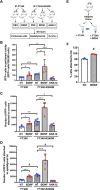Ovarian BDNF promotes survival, migration, and attachment of tumor precursors originated from p53 mutant fallopian tube epithelial cells
- PMID: 32471985
- PMCID: PMC7260207
- DOI: 10.1038/s41389-020-0243-y
Ovarian BDNF promotes survival, migration, and attachment of tumor precursors originated from p53 mutant fallopian tube epithelial cells
Abstract
High-grade serous ovarian carcinoma (HGSOC) is the most lethal gynecological malignancy. New evidence supports a hypothesis that HGSOC can originate from fallopian tube epithelium (FTE). It is unclear how genetic alterations and pathophysiological processes drive the progression of FTE tumor precursors into widespread HGSOCs. In this study, we uncovered that brain-derived neurotrophic factor (BDNF) in the follicular fluid stimulates the tropomyosin receptor kinase B (TrkB)-expressing FTE cells to promote their survival, migration, and attachment. Using in vitro and in vivo models, we further identified that the acquisition of common TP53 gain-of-function (GOF) mutations in FTE cells led to enhanced BDNF/TrkB signaling compared to that of FTE cells with TP53 loss-of-function (LOF) mutations. Different mutant p53 proteins can either increase TrkB transcription or enhance TrkB endocytic recycling. Our findings have demonstrated possible interplays between genetic alterations in FTE tumor precursors (i.e., p53 GOF mutations) and pathophysiological processes (i.e., the release of follicular fluid upon ovulation) during the initiation of HGSOC from the fallopian tube. Our data revealed molecular events underlying the link between HGSOC tumorigenesis and ovulation, a physiological process that has been associated with risk factors of HGSOC.
Conflict of interest statement
The authors declare that they have no conflict of interest.
Figures






Similar articles
-
MYC is sufficient to generate mid-life high-grade serous ovarian and uterine serous carcinomas in a p53-R270H mouse model.bioRxiv [Preprint]. 2024 Jan 29:2024.01.24.576924. doi: 10.1101/2024.01.24.576924. bioRxiv. 2024. Update in: Cancer Res Commun. 2024 Sep 1;4(9):2525-2538. doi: 10.1158/2767-9764.CRC-24-0144. PMID: 38352443 Free PMC article. Updated. Preprint.
-
MYC is Sufficient to Generate Mid-Life High-Grade Serous Ovarian and Uterine Serous Carcinomas in a p53-R270H Mouse Model.Cancer Res Commun. 2024 Sep 1;4(9):2525-2538. doi: 10.1158/2767-9764.CRC-24-0144. Cancer Res Commun. 2024. PMID: 39225558 Free PMC article.
-
Human peritoneal fluid exerts ovulation- and nonovulation-sourced oncogenic activities on transforming fallopian tube epithelial cells.Cancer Cell Int. 2024 Jul 2;24(1):231. doi: 10.1186/s12935-024-03406-1. Cancer Cell Int. 2024. PMID: 38956560 Free PMC article.
-
Exploring the Role of Fallopian Ciliated Cells in the Pathogenesis of High-Grade Serous Ovarian Cancer.Int J Mol Sci. 2018 Aug 24;19(9):2512. doi: 10.3390/ijms19092512. Int J Mol Sci. 2018. PMID: 30149579 Free PMC article. Review.
-
Fallopian tube initiation of high grade serous ovarian cancer and ovarian metastasis: Mechanisms and therapeutic implications.Cancer Lett. 2020 Apr 28;476:152-160. doi: 10.1016/j.canlet.2020.02.017. Epub 2020 Feb 15. Cancer Lett. 2020. PMID: 32067992 Free PMC article. Review.
Cited by
-
Multivariate logistic regression analysis of the correlation between five biomarkers and ovarian cancer in patients with intermediate-risk: A prospective cross-sectional study.Front Cell Dev Biol. 2022 Aug 31;10:876071. doi: 10.3389/fcell.2022.876071. eCollection 2022. Front Cell Dev Biol. 2022. PMID: 36120557 Free PMC article.
-
Models for measuring metabolic chemical changes in the metastasis of high grade serous ovarian cancer: fallopian tube, ovary, and omentum.Mol Omics. 2021 Dec 6;17(6):819-832. doi: 10.1039/d1mo00074h. Mol Omics. 2021. PMID: 34338690 Free PMC article. Review.
-
Pyrazolo[1,5-a]pyrimidine as a Prominent Framework for Tropomyosin Receptor Kinase (Trk) Inhibitors-Synthetic Strategies and SAR Insights.Molecules. 2024 Jul 29;29(15):3560. doi: 10.3390/molecules29153560. Molecules. 2024. PMID: 39124968 Free PMC article. Review.
-
The relationship between acid-sensing ion channel, ASIC2, and oncogenic β-catenin signaling in ovarian cancer.Sci Rep. 2025 May 28;15(1):18633. doi: 10.1038/s41598-025-03429-2. Sci Rep. 2025. PMID: 40437028 Free PMC article.
-
Gain-of-function p53R175H blocks apoptosis in a precursor model of ovarian high-grade serous carcinoma.Sci Rep. 2023 Jul 14;13(1):11424. doi: 10.1038/s41598-023-38609-5. Sci Rep. 2023. PMID: 37452087 Free PMC article.
References
-
- Bell DA. Origins and molecular pathology of ovarian cancer. Mod. Pathol. 2005;18(Suppl 2):S19–S32. - PubMed
-
- Werness BA, et al. Altered surface and cyst epithelium of ovaries removed prophylactically from women with a family history of ovarian cancer. Hum. Pathol. 1999;30:151–157. - PubMed
-
- Bell DA, Scully RE. Early de novo ovarian carcinoma. A study of fourteen cases. Cancer. 1994;73:1859–1864. - PubMed
-
- Callahan MJ, et al. Primary fallopian tube malignancies in BRCA-positive women undergoing surgery for ovarian cancer risk reduction. J. Clin. Oncol. 2007;25:3985–3990. - PubMed
-
- Carcangiu ML, et al. Atypical epithelial proliferation in fallopian tubes in prophylactic salpingo-oophorectomy specimens from BRCA1 and BRCA2 germline mutation carriers. Int. J. Gynecol. Pathol. 2004;23:35–40. - PubMed
Grants and funding
LinkOut - more resources
Full Text Sources
Other Literature Sources
Research Materials
Miscellaneous

